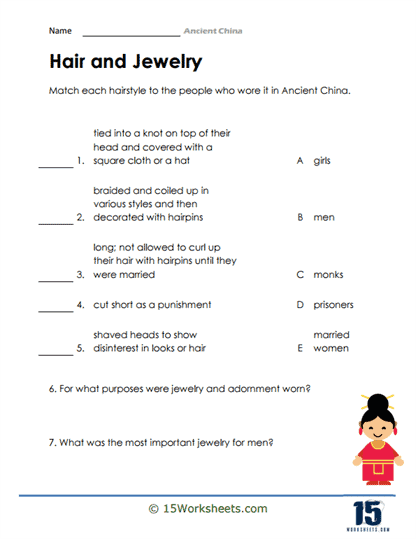Hair and Jewelry

Worksheet Description
The worksheet peers into the significance of different hairstyles and adornments in Ancient China. It describes specific hairstyles and prompts students to match them with the respective groups of people who traditionally wore them. Additionally, it poses questions about the purpose of jewelry and adornments and seeks insights into what was considered the most significant piece of jewelry for men during that era. The theme revolves around understanding the cultural importance and symbolism behind hair and jewelry in ancient Chinese society.
To address the worksheet effectively, students should first read the descriptions of the various hairstyles. After grasping the unique characteristics and significance of each style, they should use logical deduction to match them with the groups provided on the right. For the subsequent questions about jewelry and adornments, students will need to apply their knowledge of Ancient China or rely on external resources to provide informed responses. Throughout the activity, students should keep in mind the cultural and societal nuances of Ancient China to ensure their answers resonate with the historical context.
This worksheet is designed to impart knowledge about the cultural and symbolic significance of hairstyles and jewelry in Ancient China. By emphasizing the relationship between specific styles and societal groups, it underscores the role of appearance in denoting status, identity, and societal norms. Additionally, the questions about adornments aim to foster a broader understanding of the importance of jewelry beyond mere aesthetics, showcasing its value as an indicator of wealth, status, or societal roles. Through this exercise, students learn to appreciate the intricate relationship between fashion, symbolism, and culture in historical contexts.
